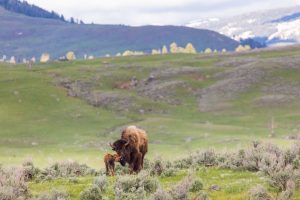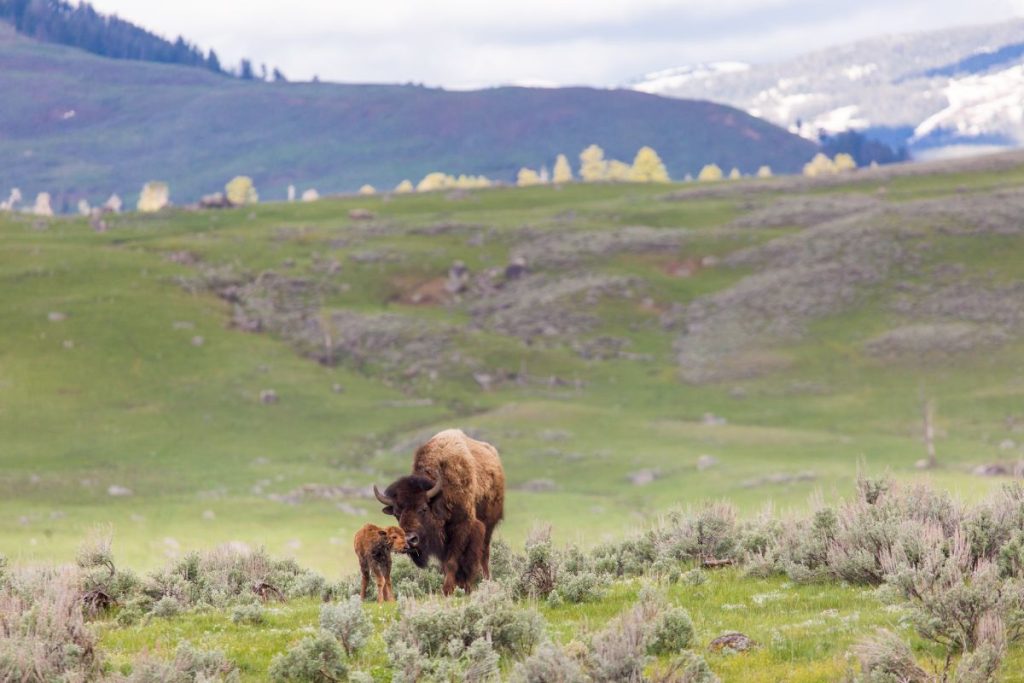Past, present, and future are honored as dozens of bison roam their historic range on the Fork Peck Indian Reservation once again in the largest bison transfer in Yellowstone National Park’s history.
During the week of January 10, the National Park Service (N.P.S.) and Animal and Plant Health Inspection Spark’s (A.P.H.I.S.) completed the transfer of 112 Yellowstone bison to the Fort Peck Indian Reservation in Poplar, Montana. The movement of these animals constitutes the single largest transfer to date under the park’s Bison Conservation Transfer Program.
The bison transferred last month were a large family group of seven males, 53 females, and 52 calves. All completed Phases I & II of the brucellosis quarantine protocol at Yellowstone National Park and the A.P.H.I.S. facilities and will finish assurance testing (Phase III) at Fort Peck (see information below for details about the protocol.)
Since 2019, 294 bison have been transferred from Yellowstone to the Assiniboine and Sioux Tribes at Fort Peck. Approximately 170 of those bison have been further distributed to 23 Tribes across 12 states in partnership with the InterTribal Buffalo Council.

Courtesy N.P.S. & Neal Herbert
Yellowstone’s Bison Conservation Program has led to the largest relocation of live Yellowstone bison to American Indian Tribes in history.
This transfer is the result of many partners working together:
- N.P.S./Department of the Interior
- Assiniboine and Sioux Tribes of the Fort Peck Indian Reservation
- A.P.H.I.S./United States Department of Agriculture
- The State of Montana
- InterTribal Buffalo Council
- Yellowstone Forever
- Defenders of Wildlife
- The Greater Yellowstone Coalition
Yellowstone National Park partnered recently with Yellowstone Forever and the Greater Yellowstone Coalition to more than double the facility’s capacity within the park. As a result, the park and A.P.H.I.S. intend to enter 250 new animals into the program this winter.
“We greatly appreciate the tremendous number of partners who have come together to make the Bison Conservation Transfer Program a success,” said Superintendent” Cam Sholly. “It is important we continue to look for opportunities to build on the success of this program to move larger numbers of disease-free bison to Tribes across the country while also achieving our future goal of eliminating shipments to slaughter.”
Background information about quarantine
Quarantine was included as a possible tactic for bison management back in 2001 when the Interagency Bison Management Plan (I.B.M.P.) was signed by the Secretaries of Interior and Agriculture and the Governor of Montana. The National Park Service formally pursued a quarantine program in 2014 by initiating a public planning process. The operational quarantine program was approved in May 2018.
A.P.H.I.S. and D.O.L. established the final structural specifications and biosecurity requirements for quarantine facilities in June 2017. Stephens Creek in Yellowstone National Park, Corwin Springs in Montana, and the Fort Peck Reservation are the only facilities that meet those specifications.
A.P.H.I.S. developed the quarantine protocols in October 2003 and validated them during 2005-2010. Quarantine has three phases:
Phase I
Managers capture bison in or near the park during winter. Bison considered suitable for quarantine based on initial negative tests for brucellosis are isolated in double-fenced quarantine pastures and tested every 30-45 days until all bison test negative for two consecutive testing periods.
Phase II
Bison in these individual test groups undergo brucellosis testing by age and sex requirements described in the 2003 Brucellosis Eradication: Uniform Methods and Rules (APHIS 91–45–013) and are certified as brucellosis-free.
Phase III
Managers can transfer bison to other fenced pastures. In the new location, brucellosis tests are conducted at six and 12 months to provide additional assurance. Managers keep these bison separate from other animals until the six-month test is completed. Afterward, managers can release these bison on public or tribal lands for conservation and cultural purposes.










